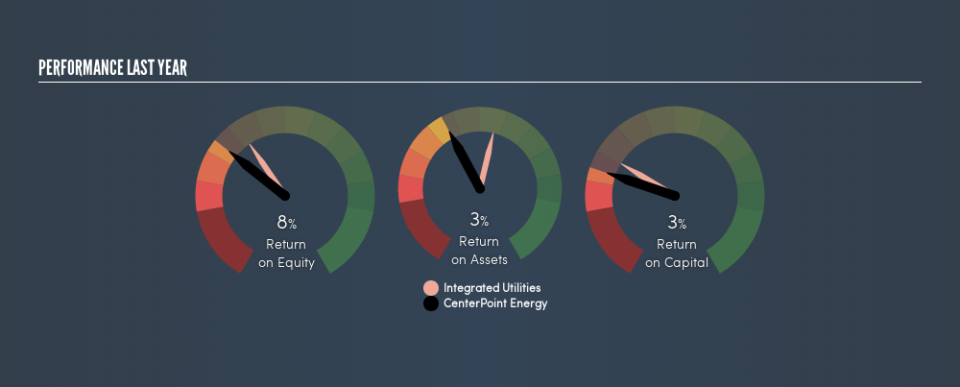Why CenterPoint Energy, Inc.’s (NYSE:CNP) Return On Capital Employed Might Be A Concern

Today we'll evaluate CenterPoint Energy, Inc. (NYSE:CNP) to determine whether it could have potential as an investment idea. Specifically, we'll consider its Return On Capital Employed (ROCE), since that will give us an insight into how efficiently the business can generate profits from the capital it requires.
First, we'll go over how we calculate ROCE. Next, we'll compare it to others in its industry. Finally, we'll look at how its current liabilities affect its ROCE.
What is Return On Capital Employed (ROCE)?
ROCE is a metric for evaluating how much pre-tax income (in percentage terms) a company earns on the capital invested in its business. Generally speaking a higher ROCE is better. Overall, it is a valuable metric that has its flaws. Renowned investment researcher Michael Mauboussin has suggested that a high ROCE can indicate that 'one dollar invested in the company generates value of more than one dollar'.
So, How Do We Calculate ROCE?
The formula for calculating the return on capital employed is:
Return on Capital Employed = Earnings Before Interest and Tax (EBIT) ÷ (Total Assets - Current Liabilities)
Or for CenterPoint Energy:
0.034 = US$1.1b ÷ (US$34b - US$3.0b) (Based on the trailing twelve months to June 2019.)
So, CenterPoint Energy has an ROCE of 3.4%.
Check out our latest analysis for CenterPoint Energy
Is CenterPoint Energy's ROCE Good?
One way to assess ROCE is to compare similar companies. Using our data, CenterPoint Energy's ROCE appears to be significantly below the 4.9% average in the Integrated Utilities industry. This performance is not ideal, as it suggests the company may not be deploying its capital as effectively as some competitors. Regardless of how CenterPoint Energy stacks up against its industry, its ROCE in absolute terms is quite low (especially compared to a bank account). There are potentially more appealing investments elsewhere.
CenterPoint Energy's current ROCE of 3.4% is lower than 3 years ago, when the company reported a 4.9% ROCE. Therefore we wonder if the company is facing new headwinds. The image below shows how CenterPoint Energy's ROCE compares to its industry, and you can click it to see more detail on its past growth.
When considering this metric, keep in mind that it is backwards looking, and not necessarily predictive. ROCE can be misleading for companies in cyclical industries, with returns looking impressive during the boom times, but very weak during the busts. ROCE is, after all, simply a snap shot of a single year. Since the future is so important for investors, you should check out our free report on analyst forecasts for CenterPoint Energy.
How CenterPoint Energy's Current Liabilities Impact Its ROCE
Current liabilities include invoices, such as supplier payments, short-term debt, or a tax bill, that need to be paid within 12 months. Due to the way ROCE is calculated, a high level of current liabilities makes a company look as though it has less capital employed, and thus can (sometimes unfairly) boost the ROCE. To check the impact of this, we calculate if a company has high current liabilities relative to its total assets.
CenterPoint Energy has total liabilities of US$3.0b and total assets of US$34b. Therefore its current liabilities are equivalent to approximately 8.8% of its total assets. CenterPoint Energy has a low level of current liabilities, which have a negligible impact on its already low ROCE.
Our Take On CenterPoint Energy's ROCE
Nonetheless, there may be better places to invest your capital. You might be able to find a better investment than CenterPoint Energy. If you want a selection of possible winners, check out this free list of interesting companies that trade on a P/E below 20 (but have proven they can grow earnings).
For those who like to find winning investments this free list of growing companies with recent insider purchasing, could be just the ticket.
We aim to bring you long-term focused research analysis driven by fundamental data. Note that our analysis may not factor in the latest price-sensitive company announcements or qualitative material.
If you spot an error that warrants correction, please contact the editor at editorial-team@simplywallst.com. This article by Simply Wall St is general in nature. It does not constitute a recommendation to buy or sell any stock, and does not take account of your objectives, or your financial situation. Simply Wall St has no position in the stocks mentioned. Thank you for reading.

 Yahoo Finance
Yahoo Finance 
